Organizational Behavior Analysis: The ADFA Failure Case Study
VerifiedAdded on 2023/06/04
|13
|3447
|459
Case Study
AI Summary
This case study examines the organizational failure at the Australian Defence Force Academy (ADFA), focusing on the factors that contributed to the sexual harassment scandals and the subsequent downfall of the institution. The analysis delves into individual factors such as personality, values, and moral development, alongside group dynamics including organizational culture, subcultures, and group processes. The study also explores the role of policies, procedures, and control systems in exacerbating the issues. Key themes include the masculine culture, male dominance, bystander effect, and poor leadership as contributing factors. Post-failure responses and the implemented changes are also discussed. The case study highlights the impact of unethical behavior, the importance of ethical leadership, and the consequences of neglecting organizational culture, offering valuable lessons for leadership management and organizational behavior.
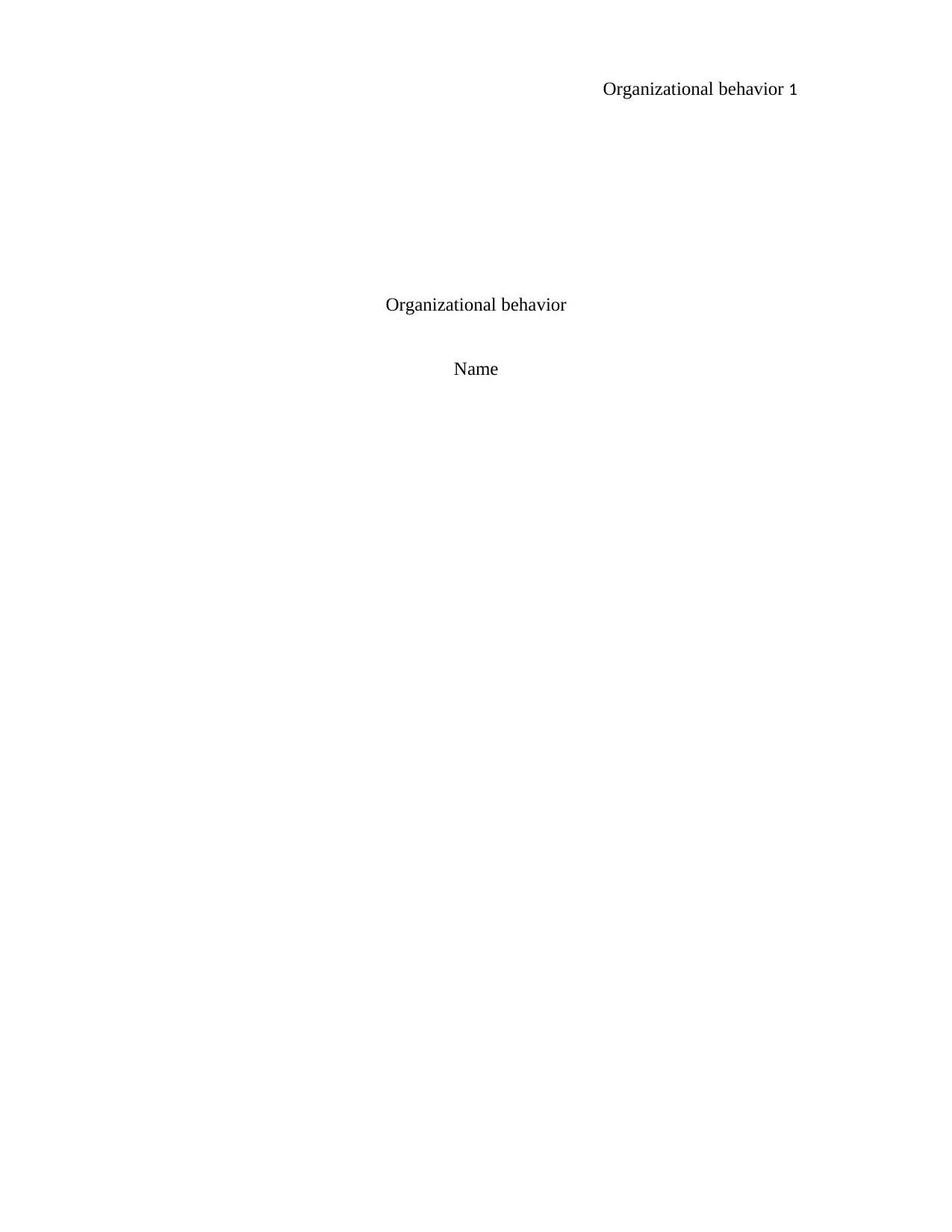
Organizational behavior 1
Organizational behavior
Name
Organizational behavior
Name
Paraphrase This Document
Need a fresh take? Get an instant paraphrase of this document with our AI Paraphraser
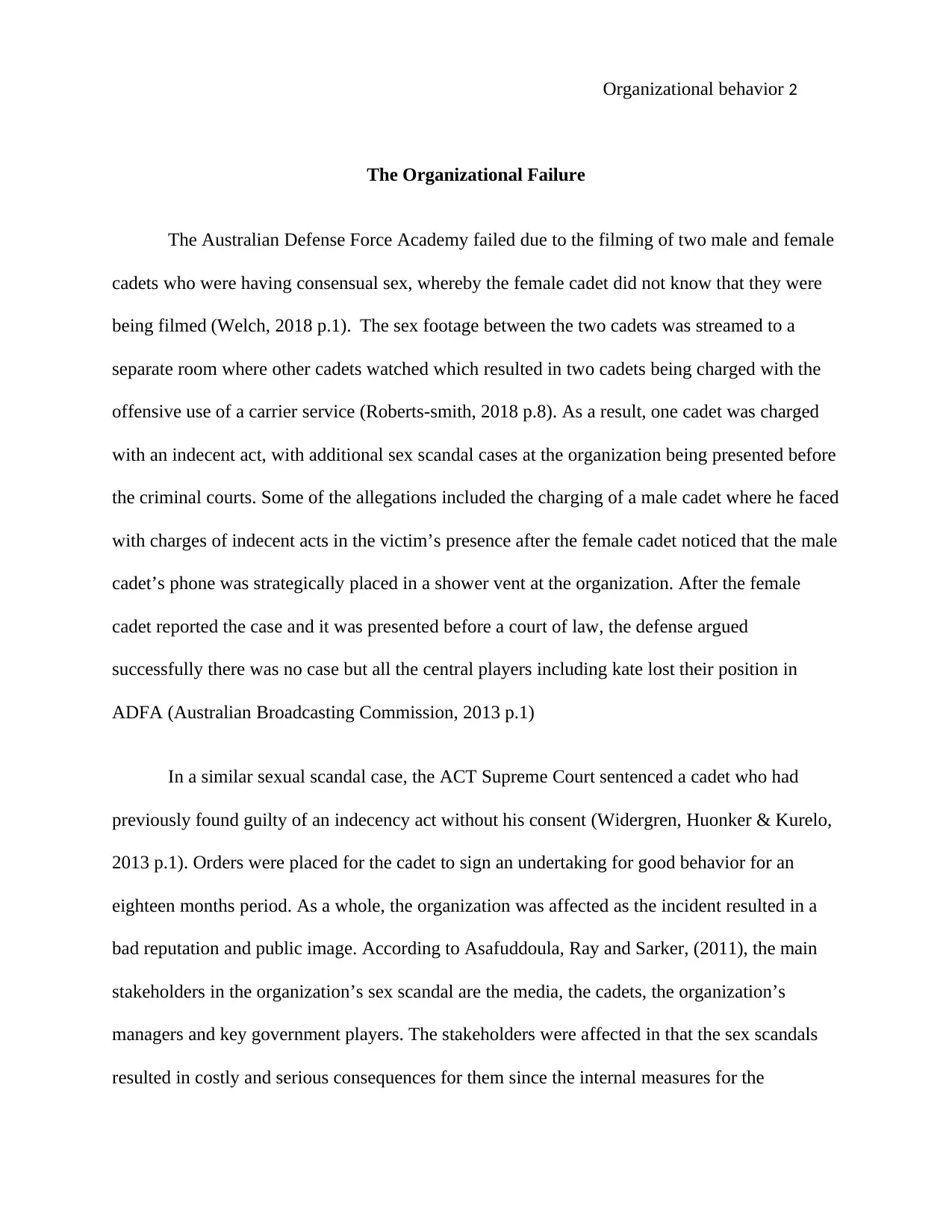
Organizational behavior 2
The Organizational Failure
The Australian Defense Force Academy failed due to the filming of two male and female
cadets who were having consensual sex, whereby the female cadet did not know that they were
being filmed (Welch, 2018 p.1). The sex footage between the two cadets was streamed to a
separate room where other cadets watched which resulted in two cadets being charged with the
offensive use of a carrier service (Roberts-smith, 2018 p.8). As a result, one cadet was charged
with an indecent act, with additional sex scandal cases at the organization being presented before
the criminal courts. Some of the allegations included the charging of a male cadet where he faced
with charges of indecent acts in the victim’s presence after the female cadet noticed that the male
cadet’s phone was strategically placed in a shower vent at the organization. After the female
cadet reported the case and it was presented before a court of law, the defense argued
successfully there was no case but all the central players including kate lost their position in
ADFA (Australian Broadcasting Commission, 2013 p.1)
In a similar sexual scandal case, the ACT Supreme Court sentenced a cadet who had
previously found guilty of an indecency act without his consent (Widergren, Huonker & Kurelo,
2013 p.1). Orders were placed for the cadet to sign an undertaking for good behavior for an
eighteen months period. As a whole, the organization was affected as the incident resulted in a
bad reputation and public image. According to Asafuddoula, Ray and Sarker, (2011), the main
stakeholders in the organization’s sex scandal are the media, the cadets, the organization’s
managers and key government players. The stakeholders were affected in that the sex scandals
resulted in costly and serious consequences for them since the internal measures for the
The Organizational Failure
The Australian Defense Force Academy failed due to the filming of two male and female
cadets who were having consensual sex, whereby the female cadet did not know that they were
being filmed (Welch, 2018 p.1). The sex footage between the two cadets was streamed to a
separate room where other cadets watched which resulted in two cadets being charged with the
offensive use of a carrier service (Roberts-smith, 2018 p.8). As a result, one cadet was charged
with an indecent act, with additional sex scandal cases at the organization being presented before
the criminal courts. Some of the allegations included the charging of a male cadet where he faced
with charges of indecent acts in the victim’s presence after the female cadet noticed that the male
cadet’s phone was strategically placed in a shower vent at the organization. After the female
cadet reported the case and it was presented before a court of law, the defense argued
successfully there was no case but all the central players including kate lost their position in
ADFA (Australian Broadcasting Commission, 2013 p.1)
In a similar sexual scandal case, the ACT Supreme Court sentenced a cadet who had
previously found guilty of an indecency act without his consent (Widergren, Huonker & Kurelo,
2013 p.1). Orders were placed for the cadet to sign an undertaking for good behavior for an
eighteen months period. As a whole, the organization was affected as the incident resulted in a
bad reputation and public image. According to Asafuddoula, Ray and Sarker, (2011), the main
stakeholders in the organization’s sex scandal are the media, the cadets, the organization’s
managers and key government players. The stakeholders were affected in that the sex scandals
resulted in costly and serious consequences for them since the internal measures for the
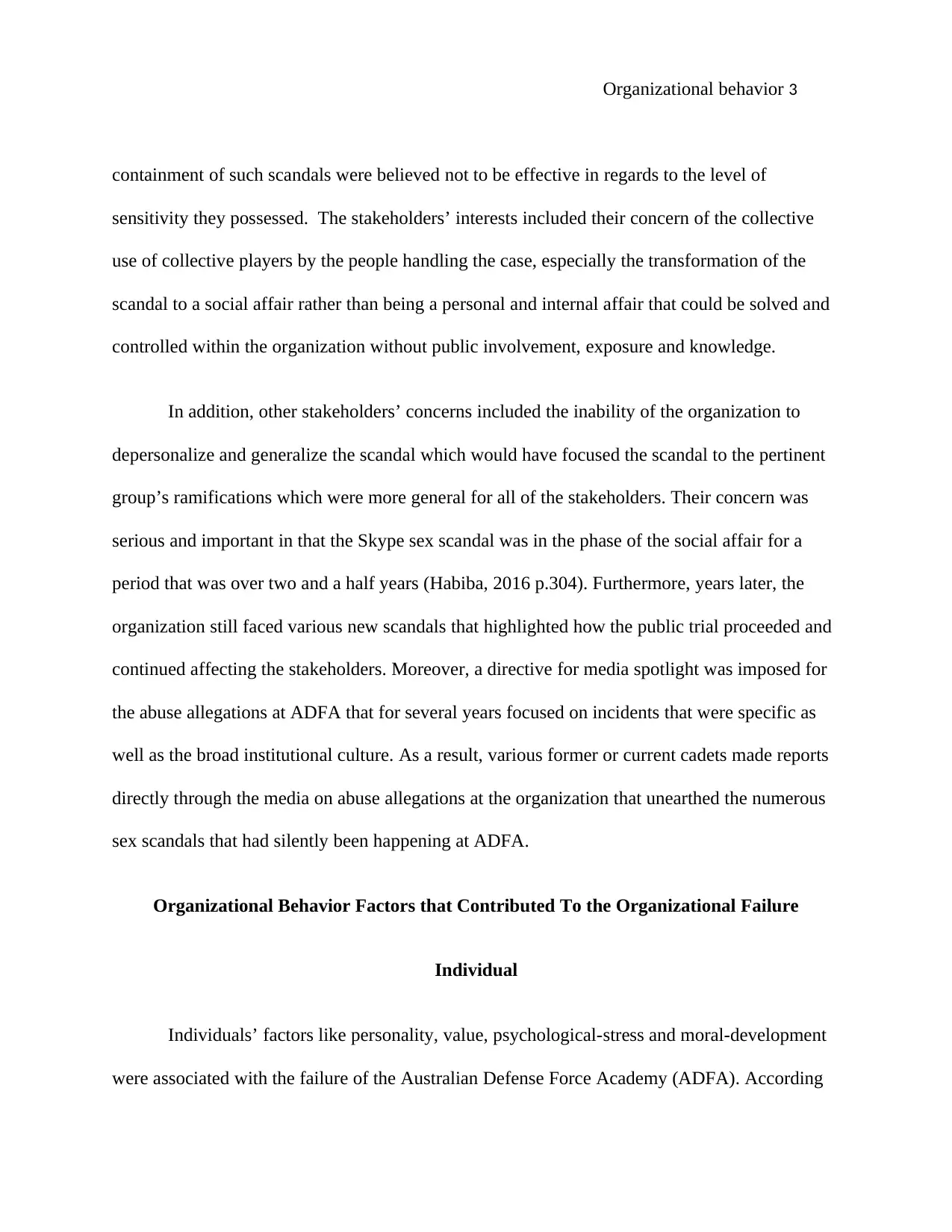
Organizational behavior 3
containment of such scandals were believed not to be effective in regards to the level of
sensitivity they possessed. The stakeholders’ interests included their concern of the collective
use of collective players by the people handling the case, especially the transformation of the
scandal to a social affair rather than being a personal and internal affair that could be solved and
controlled within the organization without public involvement, exposure and knowledge.
In addition, other stakeholders’ concerns included the inability of the organization to
depersonalize and generalize the scandal which would have focused the scandal to the pertinent
group’s ramifications which were more general for all of the stakeholders. Their concern was
serious and important in that the Skype sex scandal was in the phase of the social affair for a
period that was over two and a half years (Habiba, 2016 p.304). Furthermore, years later, the
organization still faced various new scandals that highlighted how the public trial proceeded and
continued affecting the stakeholders. Moreover, a directive for media spotlight was imposed for
the abuse allegations at ADFA that for several years focused on incidents that were specific as
well as the broad institutional culture. As a result, various former or current cadets made reports
directly through the media on abuse allegations at the organization that unearthed the numerous
sex scandals that had silently been happening at ADFA.
Organizational Behavior Factors that Contributed To the Organizational Failure
Individual
Individuals’ factors like personality, value, psychological-stress and moral-development
were associated with the failure of the Australian Defense Force Academy (ADFA). According
containment of such scandals were believed not to be effective in regards to the level of
sensitivity they possessed. The stakeholders’ interests included their concern of the collective
use of collective players by the people handling the case, especially the transformation of the
scandal to a social affair rather than being a personal and internal affair that could be solved and
controlled within the organization without public involvement, exposure and knowledge.
In addition, other stakeholders’ concerns included the inability of the organization to
depersonalize and generalize the scandal which would have focused the scandal to the pertinent
group’s ramifications which were more general for all of the stakeholders. Their concern was
serious and important in that the Skype sex scandal was in the phase of the social affair for a
period that was over two and a half years (Habiba, 2016 p.304). Furthermore, years later, the
organization still faced various new scandals that highlighted how the public trial proceeded and
continued affecting the stakeholders. Moreover, a directive for media spotlight was imposed for
the abuse allegations at ADFA that for several years focused on incidents that were specific as
well as the broad institutional culture. As a result, various former or current cadets made reports
directly through the media on abuse allegations at the organization that unearthed the numerous
sex scandals that had silently been happening at ADFA.
Organizational Behavior Factors that Contributed To the Organizational Failure
Individual
Individuals’ factors like personality, value, psychological-stress and moral-development
were associated with the failure of the Australian Defense Force Academy (ADFA). According
⊘ This is a preview!⊘
Do you want full access?
Subscribe today to unlock all pages.

Trusted by 1+ million students worldwide
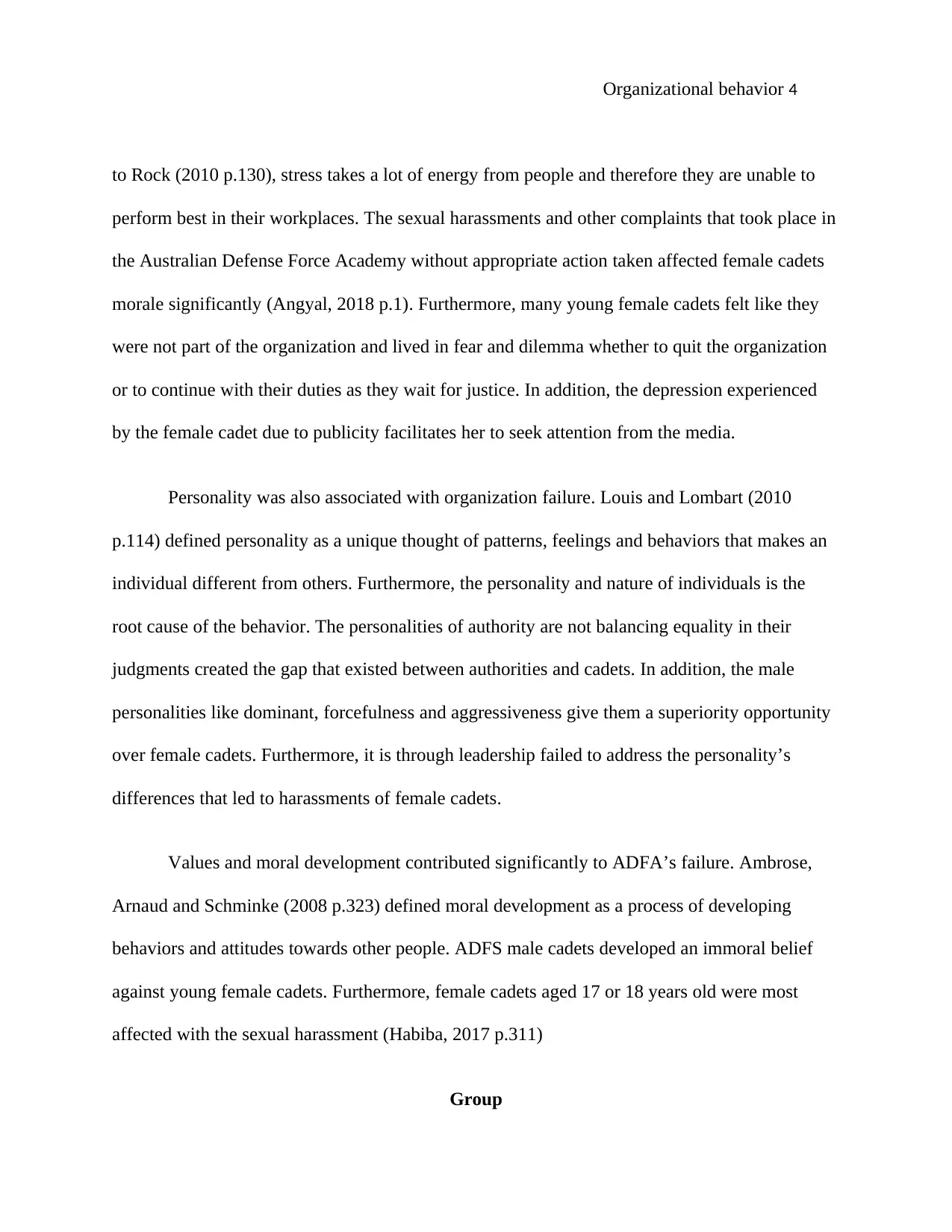
Organizational behavior 4
to Rock (2010 p.130), stress takes a lot of energy from people and therefore they are unable to
perform best in their workplaces. The sexual harassments and other complaints that took place in
the Australian Defense Force Academy without appropriate action taken affected female cadets
morale significantly (Angyal, 2018 p.1). Furthermore, many young female cadets felt like they
were not part of the organization and lived in fear and dilemma whether to quit the organization
or to continue with their duties as they wait for justice. In addition, the depression experienced
by the female cadet due to publicity facilitates her to seek attention from the media.
Personality was also associated with organization failure. Louis and Lombart (2010
p.114) defined personality as a unique thought of patterns, feelings and behaviors that makes an
individual different from others. Furthermore, the personality and nature of individuals is the
root cause of the behavior. The personalities of authority are not balancing equality in their
judgments created the gap that existed between authorities and cadets. In addition, the male
personalities like dominant, forcefulness and aggressiveness give them a superiority opportunity
over female cadets. Furthermore, it is through leadership failed to address the personality’s
differences that led to harassments of female cadets.
Values and moral development contributed significantly to ADFA’s failure. Ambrose,
Arnaud and Schminke (2008 p.323) defined moral development as a process of developing
behaviors and attitudes towards other people. ADFS male cadets developed an immoral belief
against young female cadets. Furthermore, female cadets aged 17 or 18 years old were most
affected with the sexual harassment (Habiba, 2017 p.311)
Group
to Rock (2010 p.130), stress takes a lot of energy from people and therefore they are unable to
perform best in their workplaces. The sexual harassments and other complaints that took place in
the Australian Defense Force Academy without appropriate action taken affected female cadets
morale significantly (Angyal, 2018 p.1). Furthermore, many young female cadets felt like they
were not part of the organization and lived in fear and dilemma whether to quit the organization
or to continue with their duties as they wait for justice. In addition, the depression experienced
by the female cadet due to publicity facilitates her to seek attention from the media.
Personality was also associated with organization failure. Louis and Lombart (2010
p.114) defined personality as a unique thought of patterns, feelings and behaviors that makes an
individual different from others. Furthermore, the personality and nature of individuals is the
root cause of the behavior. The personalities of authority are not balancing equality in their
judgments created the gap that existed between authorities and cadets. In addition, the male
personalities like dominant, forcefulness and aggressiveness give them a superiority opportunity
over female cadets. Furthermore, it is through leadership failed to address the personality’s
differences that led to harassments of female cadets.
Values and moral development contributed significantly to ADFA’s failure. Ambrose,
Arnaud and Schminke (2008 p.323) defined moral development as a process of developing
behaviors and attitudes towards other people. ADFS male cadets developed an immoral belief
against young female cadets. Furthermore, female cadets aged 17 or 18 years old were most
affected with the sexual harassment (Habiba, 2017 p.311)
Group
Paraphrase This Document
Need a fresh take? Get an instant paraphrase of this document with our AI Paraphraser

Organizational behavior 5
Organizational Culture, Subculture, Group Processes
Organization culture and subculture is as a system of shared beliefs, values, experiences,
attitudes and psychology that develops within an organization and guides the behavior of
members (Wu et al., 2010 p.670). Australian Defense Force Academy (ADFA) in the case has a
culture that influenced the workforces were managed. The feminism culture in the Australian
Defense Force Academy (ADFA) was very high with environment dominated by male cadets.
The culture considered women as inferiors in the organization with limited rights of expression.
The offender’s actions in the Australian Defense Force Academy (ADFA) was taken lightly
whenever the female’s cadet reported their concerns. Furthermore, the female cadet published
the concerns to media because she knew the accused could only face “minor ‘prejudicial
conduct’ charge” (Snow & Oakes 2011 p.6). In addition, the females were subordinate, they
could not raise their voices against superiors, and if they did, they were subjected for different
abuse ranging from being bullied, sexually harassed and physically abused.
The culture of Australian Defense Force Academy (ADFA) discourages honesty
approaches hence allowing the unethical behavior to spread unimpeded. According to Stevens
(2008 p.601), a company should encourage the staff to report any emerging ethical behavior
before the problem widespread. However, with accordance to ADFA culture, complainants were
excluded or isolated by other cadets after reporting the instances of abuses. Furthermore, the
complainants were exposed to more sexual harassments after reporting. If ADFA had a positive
culture of addressing the need then workforce conflicts that existed between the management
could not reach public spheres and spoil Australian Defense Force Academy (ADFA) reputation.
Organizational Culture, Subculture, Group Processes
Organization culture and subculture is as a system of shared beliefs, values, experiences,
attitudes and psychology that develops within an organization and guides the behavior of
members (Wu et al., 2010 p.670). Australian Defense Force Academy (ADFA) in the case has a
culture that influenced the workforces were managed. The feminism culture in the Australian
Defense Force Academy (ADFA) was very high with environment dominated by male cadets.
The culture considered women as inferiors in the organization with limited rights of expression.
The offender’s actions in the Australian Defense Force Academy (ADFA) was taken lightly
whenever the female’s cadet reported their concerns. Furthermore, the female cadet published
the concerns to media because she knew the accused could only face “minor ‘prejudicial
conduct’ charge” (Snow & Oakes 2011 p.6). In addition, the females were subordinate, they
could not raise their voices against superiors, and if they did, they were subjected for different
abuse ranging from being bullied, sexually harassed and physically abused.
The culture of Australian Defense Force Academy (ADFA) discourages honesty
approaches hence allowing the unethical behavior to spread unimpeded. According to Stevens
(2008 p.601), a company should encourage the staff to report any emerging ethical behavior
before the problem widespread. However, with accordance to ADFA culture, complainants were
excluded or isolated by other cadets after reporting the instances of abuses. Furthermore, the
complainants were exposed to more sexual harassments after reporting. If ADFA had a positive
culture of addressing the need then workforce conflicts that existed between the management
could not reach public spheres and spoil Australian Defense Force Academy (ADFA) reputation.

Organizational behavior 6
The abuse cultures started from top management downwards to employees. The leaders
of the organization were first to abuse their office by not taking appropriate actions against the
cadets who were bullying others. Furthermore, even the senior cadets feared being bullied when
they confronted the abuse culture against the junior cadets. Therefore, it is clear that because of
the existence of this culture that limits employees from reporting abuse contributed to the under-
reporting of abuse at ADFA.
Group Processes
The group processes of ADFC involves both male and female cadets working together
and training in the same environment. The social interaction between the female and male cadets
has significantly led to vulnerabilities of sexual harassment with junior cadets. Furthermore, the
low experience and suitability of some staff members in supervising young cadets from both
genders failed to address the sexual harassments issues. Other group processes that were
associated with organizational failure include excessive use of alcohol by cadets from both
genders, low levels of supervision and security on accommodation.
Organizational Level
Policies, Procedure and Control Systems
The policies and procedures of solving problems in an organization can be a key
determinant of the success or failures. Australian Defense Force Academy (ADFA) had a long
process and procedures of addressing the employees’ concerns.
The organization procedures were believed not effective for bringing justice among the
central players as serious cases of sexual harassment took long before it was judged.
The abuse cultures started from top management downwards to employees. The leaders
of the organization were first to abuse their office by not taking appropriate actions against the
cadets who were bullying others. Furthermore, even the senior cadets feared being bullied when
they confronted the abuse culture against the junior cadets. Therefore, it is clear that because of
the existence of this culture that limits employees from reporting abuse contributed to the under-
reporting of abuse at ADFA.
Group Processes
The group processes of ADFC involves both male and female cadets working together
and training in the same environment. The social interaction between the female and male cadets
has significantly led to vulnerabilities of sexual harassment with junior cadets. Furthermore, the
low experience and suitability of some staff members in supervising young cadets from both
genders failed to address the sexual harassments issues. Other group processes that were
associated with organizational failure include excessive use of alcohol by cadets from both
genders, low levels of supervision and security on accommodation.
Organizational Level
Policies, Procedure and Control Systems
The policies and procedures of solving problems in an organization can be a key
determinant of the success or failures. Australian Defense Force Academy (ADFA) had a long
process and procedures of addressing the employees’ concerns.
The organization procedures were believed not effective for bringing justice among the
central players as serious cases of sexual harassment took long before it was judged.
⊘ This is a preview!⊘
Do you want full access?
Subscribe today to unlock all pages.

Trusted by 1+ million students worldwide
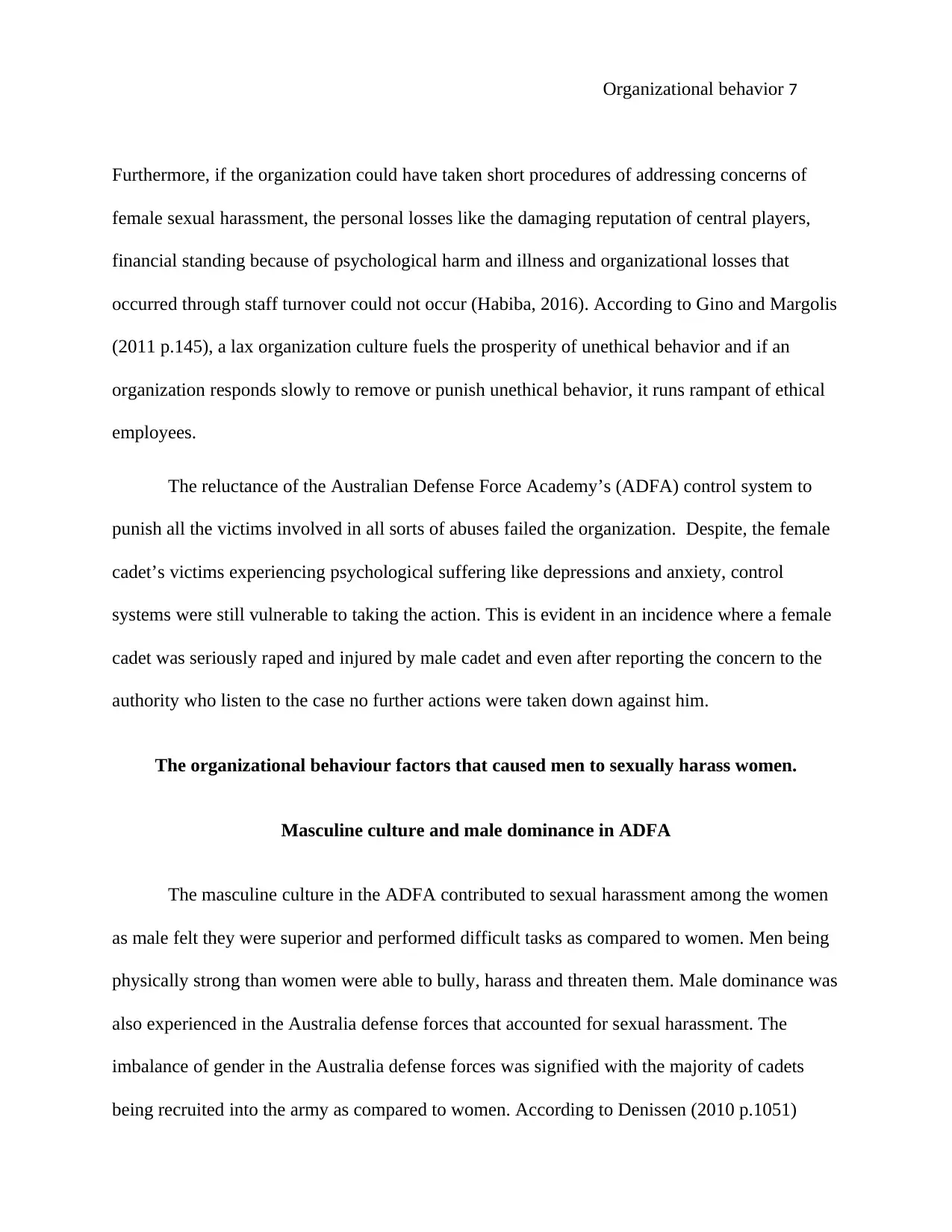
Organizational behavior 7
Furthermore, if the organization could have taken short procedures of addressing concerns of
female sexual harassment, the personal losses like the damaging reputation of central players,
financial standing because of psychological harm and illness and organizational losses that
occurred through staff turnover could not occur (Habiba, 2016). According to Gino and Margolis
(2011 p.145), a lax organization culture fuels the prosperity of unethical behavior and if an
organization responds slowly to remove or punish unethical behavior, it runs rampant of ethical
employees.
The reluctance of the Australian Defense Force Academy’s (ADFA) control system to
punish all the victims involved in all sorts of abuses failed the organization. Despite, the female
cadet’s victims experiencing psychological suffering like depressions and anxiety, control
systems were still vulnerable to taking the action. This is evident in an incidence where a female
cadet was seriously raped and injured by male cadet and even after reporting the concern to the
authority who listen to the case no further actions were taken down against him.
The organizational behaviour factors that caused men to sexually harass women.
Masculine culture and male dominance in ADFA
The masculine culture in the ADFA contributed to sexual harassment among the women
as male felt they were superior and performed difficult tasks as compared to women. Men being
physically strong than women were able to bully, harass and threaten them. Male dominance was
also experienced in the Australia defense forces that accounted for sexual harassment. The
imbalance of gender in the Australia defense forces was signified with the majority of cadets
being recruited into the army as compared to women. According to Denissen (2010 p.1051)
Furthermore, if the organization could have taken short procedures of addressing concerns of
female sexual harassment, the personal losses like the damaging reputation of central players,
financial standing because of psychological harm and illness and organizational losses that
occurred through staff turnover could not occur (Habiba, 2016). According to Gino and Margolis
(2011 p.145), a lax organization culture fuels the prosperity of unethical behavior and if an
organization responds slowly to remove or punish unethical behavior, it runs rampant of ethical
employees.
The reluctance of the Australian Defense Force Academy’s (ADFA) control system to
punish all the victims involved in all sorts of abuses failed the organization. Despite, the female
cadet’s victims experiencing psychological suffering like depressions and anxiety, control
systems were still vulnerable to taking the action. This is evident in an incidence where a female
cadet was seriously raped and injured by male cadet and even after reporting the concern to the
authority who listen to the case no further actions were taken down against him.
The organizational behaviour factors that caused men to sexually harass women.
Masculine culture and male dominance in ADFA
The masculine culture in the ADFA contributed to sexual harassment among the women
as male felt they were superior and performed difficult tasks as compared to women. Men being
physically strong than women were able to bully, harass and threaten them. Male dominance was
also experienced in the Australia defense forces that accounted for sexual harassment. The
imbalance of gender in the Australia defense forces was signified with the majority of cadets
being recruited into the army as compared to women. According to Denissen (2010 p.1051)
Paraphrase This Document
Need a fresh take? Get an instant paraphrase of this document with our AI Paraphraser
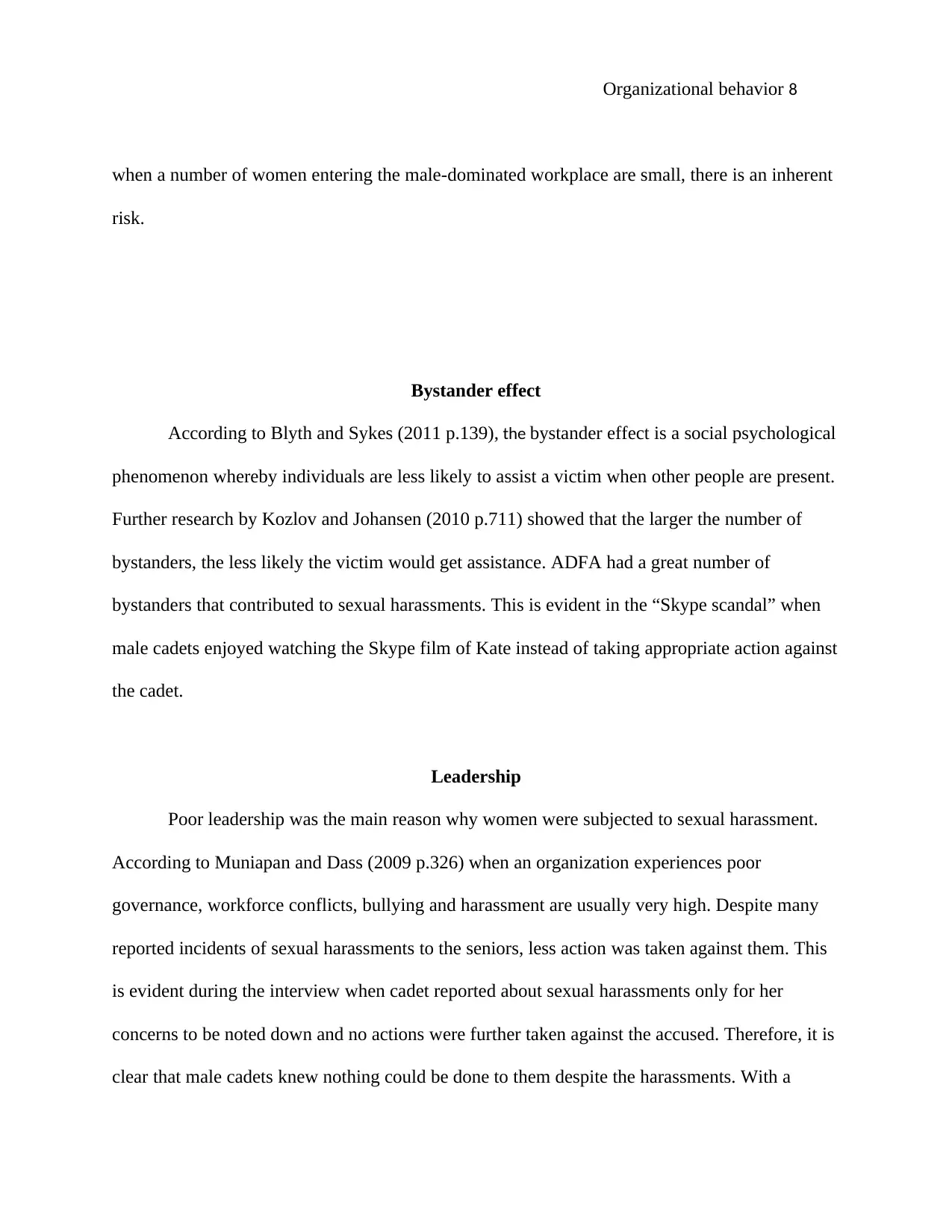
Organizational behavior 8
when a number of women entering the male-dominated workplace are small, there is an inherent
risk.
Bystander effect
According to Blyth and Sykes (2011 p.139), the bystander effect is a social psychological
phenomenon whereby individuals are less likely to assist a victim when other people are present.
Further research by Kozlov and Johansen (2010 p.711) showed that the larger the number of
bystanders, the less likely the victim would get assistance. ADFA had a great number of
bystanders that contributed to sexual harassments. This is evident in the “Skype scandal” when
male cadets enjoyed watching the Skype film of Kate instead of taking appropriate action against
the cadet.
Leadership
Poor leadership was the main reason why women were subjected to sexual harassment.
According to Muniapan and Dass (2009 p.326) when an organization experiences poor
governance, workforce conflicts, bullying and harassment are usually very high. Despite many
reported incidents of sexual harassments to the seniors, less action was taken against them. This
is evident during the interview when cadet reported about sexual harassments only for her
concerns to be noted down and no actions were further taken against the accused. Therefore, it is
clear that male cadets knew nothing could be done to them despite the harassments. With a
when a number of women entering the male-dominated workplace are small, there is an inherent
risk.
Bystander effect
According to Blyth and Sykes (2011 p.139), the bystander effect is a social psychological
phenomenon whereby individuals are less likely to assist a victim when other people are present.
Further research by Kozlov and Johansen (2010 p.711) showed that the larger the number of
bystanders, the less likely the victim would get assistance. ADFA had a great number of
bystanders that contributed to sexual harassments. This is evident in the “Skype scandal” when
male cadets enjoyed watching the Skype film of Kate instead of taking appropriate action against
the cadet.
Leadership
Poor leadership was the main reason why women were subjected to sexual harassment.
According to Muniapan and Dass (2009 p.326) when an organization experiences poor
governance, workforce conflicts, bullying and harassment are usually very high. Despite many
reported incidents of sexual harassments to the seniors, less action was taken against them. This
is evident during the interview when cadet reported about sexual harassments only for her
concerns to be noted down and no actions were further taken against the accused. Therefore, it is
clear that male cadets knew nothing could be done to them despite the harassments. With a

Organizational behavior 9
combination of both nepotism and poor leadership, the organization failed terribly to control
sexual harassments. This is evident when the accused McDonald who was a central player in the
Skype scandal was receiving a full support from a high ranked relative within the military
(McPhedran 2011 p.4). Furthermore, it seemed there were strong connections and relationship
between leaders and male cadets as the cadets were thought to be “superior” and backbone of the
organization.
Post-Failure Responses
Following the reporting of the sex scandals at ADFA, several changes were implemented.
With the clarity of the matter, the organization changed to a different institution which
encouraged the reporting and addressing of sexual scandals. In relation to the upheld relations
after the failure, changes were implemented for the management, education and supervision of
cadets (Bickerton, 2015 p.32). In addition, the reporting of abuse was advised and the
management of reported cases regarding sexual abuse was heightened. All reported cases were to
be taken with a high priority and urgency which was intended for the minimization of sexual
abuse at the institution. In addition, significant risk factors were identified and control measures,
including the minimization of male and female contact time of cadets. In addition, the recruiting
and training of cadets were greatly changed to ensure that sexual scandals were minimized by
ensuring that there were different training strategies among male and female recruits.
Furthermore, strict punishment was implemented for those found guilty of sexual offenses. The
organization also made sure that those who reported abuse were protected by regulations which
sought to minimize the victimization of reporters.
combination of both nepotism and poor leadership, the organization failed terribly to control
sexual harassments. This is evident when the accused McDonald who was a central player in the
Skype scandal was receiving a full support from a high ranked relative within the military
(McPhedran 2011 p.4). Furthermore, it seemed there were strong connections and relationship
between leaders and male cadets as the cadets were thought to be “superior” and backbone of the
organization.
Post-Failure Responses
Following the reporting of the sex scandals at ADFA, several changes were implemented.
With the clarity of the matter, the organization changed to a different institution which
encouraged the reporting and addressing of sexual scandals. In relation to the upheld relations
after the failure, changes were implemented for the management, education and supervision of
cadets (Bickerton, 2015 p.32). In addition, the reporting of abuse was advised and the
management of reported cases regarding sexual abuse was heightened. All reported cases were to
be taken with a high priority and urgency which was intended for the minimization of sexual
abuse at the institution. In addition, significant risk factors were identified and control measures,
including the minimization of male and female contact time of cadets. In addition, the recruiting
and training of cadets were greatly changed to ensure that sexual scandals were minimized by
ensuring that there were different training strategies among male and female recruits.
Furthermore, strict punishment was implemented for those found guilty of sexual offenses. The
organization also made sure that those who reported abuse were protected by regulations which
sought to minimize the victimization of reporters.
⊘ This is a preview!⊘
Do you want full access?
Subscribe today to unlock all pages.

Trusted by 1+ million students worldwide

Organizational behavior 10
The abuse complains reported attracted the attention of authorities which would lead to
trial and disqualification of the cadets from training if found guilty (Habiba, 2016 p.306).
Moreover, efforts to build an appropriate culture of respect within the organization improved to
reduce the occurrence of sexual scandals. For example, a safe reporting culture was introduced.
The changes were to ensure that those who reported sexual abuse cases used the right channel
and predefined methods. The changes benefitted the sexual abuse complainants as well as the
organization since there was now a channel for improvement on the mitigation of the sexual
scandals occurrence. The organization benefitted in that there was an anticipated improvement of
solutions to sex scandal cases which would boost the organization’s public image and trust on
the legal processes to be undertaken when sex scandals were reported. Consequently, the need
for continuous vigilance on sex scandals would ensure that the changes were observed and those
who differed prosecuted.
Generally, the changes were effective as the occurrence of sexual abuse reduced
drastically. In addition, the efforts to respond, stop and report abuse was fruitful as the few
abused cadets freely reported their issues and appropriate measures were quickly undertaken.
The stakeholders appreciated the measures undertaken to prevent sexual scandals and assisted in
solving the difficulties related to obtaining the complainant’s consent while pursuing the
allegations. However, the measures taken were still not enough since various cases in sexual
exploitation, especially of female cadets, were still prevalent.
To fully address the issues of sexual scandals, the management of ADFA should ensure
that they operate within a stricter legal framework to ensure that tough disciplinary and
The abuse complains reported attracted the attention of authorities which would lead to
trial and disqualification of the cadets from training if found guilty (Habiba, 2016 p.306).
Moreover, efforts to build an appropriate culture of respect within the organization improved to
reduce the occurrence of sexual scandals. For example, a safe reporting culture was introduced.
The changes were to ensure that those who reported sexual abuse cases used the right channel
and predefined methods. The changes benefitted the sexual abuse complainants as well as the
organization since there was now a channel for improvement on the mitigation of the sexual
scandals occurrence. The organization benefitted in that there was an anticipated improvement of
solutions to sex scandal cases which would boost the organization’s public image and trust on
the legal processes to be undertaken when sex scandals were reported. Consequently, the need
for continuous vigilance on sex scandals would ensure that the changes were observed and those
who differed prosecuted.
Generally, the changes were effective as the occurrence of sexual abuse reduced
drastically. In addition, the efforts to respond, stop and report abuse was fruitful as the few
abused cadets freely reported their issues and appropriate measures were quickly undertaken.
The stakeholders appreciated the measures undertaken to prevent sexual scandals and assisted in
solving the difficulties related to obtaining the complainant’s consent while pursuing the
allegations. However, the measures taken were still not enough since various cases in sexual
exploitation, especially of female cadets, were still prevalent.
To fully address the issues of sexual scandals, the management of ADFA should ensure
that they operate within a stricter legal framework to ensure that tough disciplinary and
Paraphrase This Document
Need a fresh take? Get an instant paraphrase of this document with our AI Paraphraser
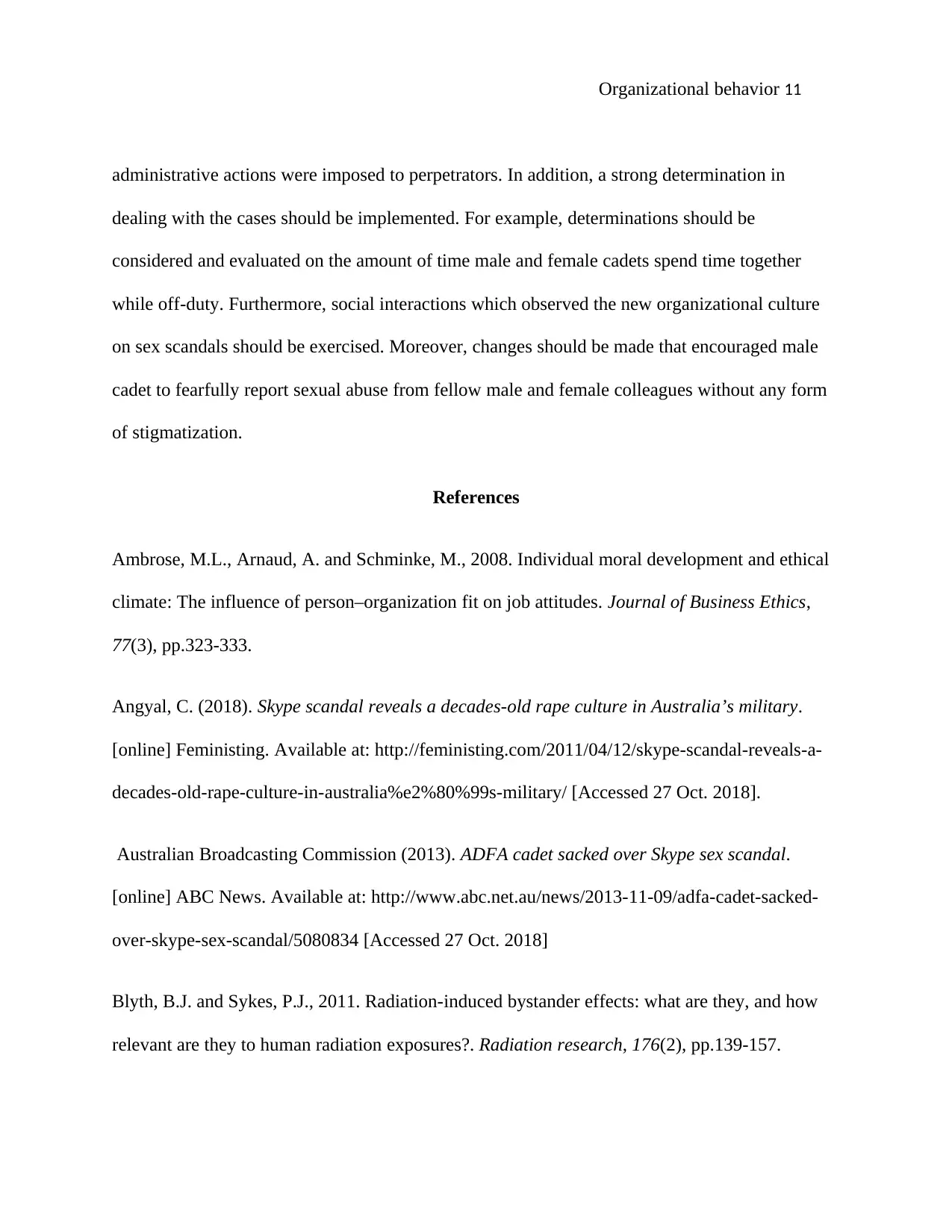
Organizational behavior 11
administrative actions were imposed to perpetrators. In addition, a strong determination in
dealing with the cases should be implemented. For example, determinations should be
considered and evaluated on the amount of time male and female cadets spend time together
while off-duty. Furthermore, social interactions which observed the new organizational culture
on sex scandals should be exercised. Moreover, changes should be made that encouraged male
cadet to fearfully report sexual abuse from fellow male and female colleagues without any form
of stigmatization.
References
Ambrose, M.L., Arnaud, A. and Schminke, M., 2008. Individual moral development and ethical
climate: The influence of person–organization fit on job attitudes. Journal of Business Ethics,
77(3), pp.323-333.
Angyal, C. (2018). Skype scandal reveals a decades-old rape culture in Australia’s military.
[online] Feministing. Available at: http://feministing.com/2011/04/12/skype-scandal-reveals-a-
decades-old-rape-culture-in-australia%e2%80%99s-military/ [Accessed 27 Oct. 2018].
Australian Broadcasting Commission (2013). ADFA cadet sacked over Skype sex scandal.
[online] ABC News. Available at: http://www.abc.net.au/news/2013-11-09/adfa-cadet-sacked-
over-skype-sex-scandal/5080834 [Accessed 27 Oct. 2018]
Blyth, B.J. and Sykes, P.J., 2011. Radiation-induced bystander effects: what are they, and how
relevant are they to human radiation exposures?. Radiation research, 176(2), pp.139-157.
administrative actions were imposed to perpetrators. In addition, a strong determination in
dealing with the cases should be implemented. For example, determinations should be
considered and evaluated on the amount of time male and female cadets spend time together
while off-duty. Furthermore, social interactions which observed the new organizational culture
on sex scandals should be exercised. Moreover, changes should be made that encouraged male
cadet to fearfully report sexual abuse from fellow male and female colleagues without any form
of stigmatization.
References
Ambrose, M.L., Arnaud, A. and Schminke, M., 2008. Individual moral development and ethical
climate: The influence of person–organization fit on job attitudes. Journal of Business Ethics,
77(3), pp.323-333.
Angyal, C. (2018). Skype scandal reveals a decades-old rape culture in Australia’s military.
[online] Feministing. Available at: http://feministing.com/2011/04/12/skype-scandal-reveals-a-
decades-old-rape-culture-in-australia%e2%80%99s-military/ [Accessed 27 Oct. 2018].
Australian Broadcasting Commission (2013). ADFA cadet sacked over Skype sex scandal.
[online] ABC News. Available at: http://www.abc.net.au/news/2013-11-09/adfa-cadet-sacked-
over-skype-sex-scandal/5080834 [Accessed 27 Oct. 2018]
Blyth, B.J. and Sykes, P.J., 2011. Radiation-induced bystander effects: what are they, and how
relevant are they to human radiation exposures?. Radiation research, 176(2), pp.139-157.
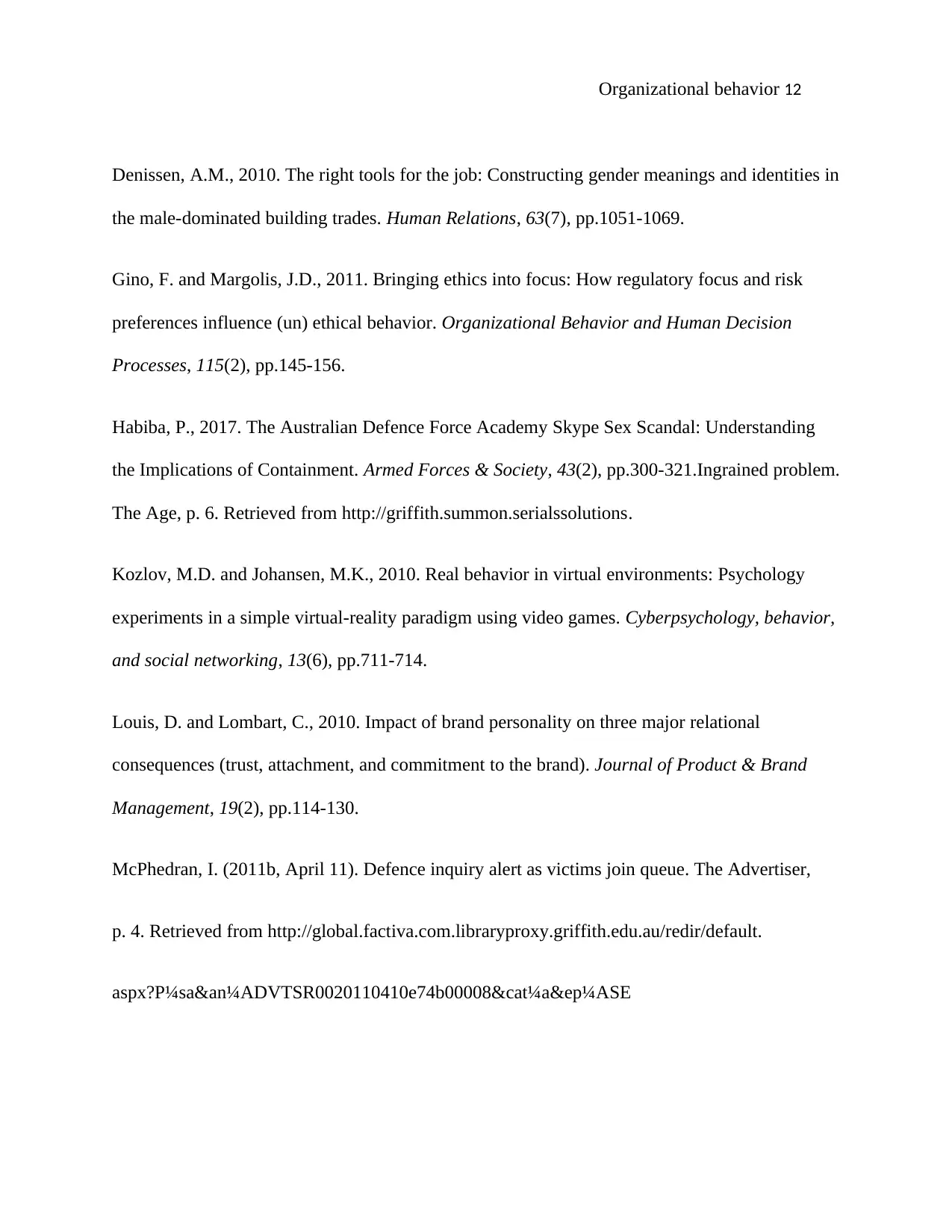
Organizational behavior 12
Denissen, A.M., 2010. The right tools for the job: Constructing gender meanings and identities in
the male-dominated building trades. Human Relations, 63(7), pp.1051-1069.
Gino, F. and Margolis, J.D., 2011. Bringing ethics into focus: How regulatory focus and risk
preferences influence (un) ethical behavior. Organizational Behavior and Human Decision
Processes, 115(2), pp.145-156.
Habiba, P., 2017. The Australian Defence Force Academy Skype Sex Scandal: Understanding
the Implications of Containment. Armed Forces & Society, 43(2), pp.300-321.Ingrained problem.
The Age, p. 6. Retrieved from http://griffith.summon.serialssolutions.
Kozlov, M.D. and Johansen, M.K., 2010. Real behavior in virtual environments: Psychology
experiments in a simple virtual-reality paradigm using video games. Cyberpsychology, behavior,
and social networking, 13(6), pp.711-714.
Louis, D. and Lombart, C., 2010. Impact of brand personality on three major relational
consequences (trust, attachment, and commitment to the brand). Journal of Product & Brand
Management, 19(2), pp.114-130.
McPhedran, I. (2011b, April 11). Defence inquiry alert as victims join queue. The Advertiser,
p. 4. Retrieved from http://global.factiva.com.libraryproxy.griffith.edu.au/redir/default.
aspx?P¼sa&an¼ADVTSR0020110410e74b00008&cat¼a&ep¼ASE
Denissen, A.M., 2010. The right tools for the job: Constructing gender meanings and identities in
the male-dominated building trades. Human Relations, 63(7), pp.1051-1069.
Gino, F. and Margolis, J.D., 2011. Bringing ethics into focus: How regulatory focus and risk
preferences influence (un) ethical behavior. Organizational Behavior and Human Decision
Processes, 115(2), pp.145-156.
Habiba, P., 2017. The Australian Defence Force Academy Skype Sex Scandal: Understanding
the Implications of Containment. Armed Forces & Society, 43(2), pp.300-321.Ingrained problem.
The Age, p. 6. Retrieved from http://griffith.summon.serialssolutions.
Kozlov, M.D. and Johansen, M.K., 2010. Real behavior in virtual environments: Psychology
experiments in a simple virtual-reality paradigm using video games. Cyberpsychology, behavior,
and social networking, 13(6), pp.711-714.
Louis, D. and Lombart, C., 2010. Impact of brand personality on three major relational
consequences (trust, attachment, and commitment to the brand). Journal of Product & Brand
Management, 19(2), pp.114-130.
McPhedran, I. (2011b, April 11). Defence inquiry alert as victims join queue. The Advertiser,
p. 4. Retrieved from http://global.factiva.com.libraryproxy.griffith.edu.au/redir/default.
aspx?P¼sa&an¼ADVTSR0020110410e74b00008&cat¼a&ep¼ASE
⊘ This is a preview!⊘
Do you want full access?
Subscribe today to unlock all pages.

Trusted by 1+ million students worldwide
1 out of 13
Your All-in-One AI-Powered Toolkit for Academic Success.
+13062052269
info@desklib.com
Available 24*7 on WhatsApp / Email
![[object Object]](/_next/static/media/star-bottom.7253800d.svg)
Unlock your academic potential
Copyright © 2020–2025 A2Z Services. All Rights Reserved. Developed and managed by ZUCOL.


